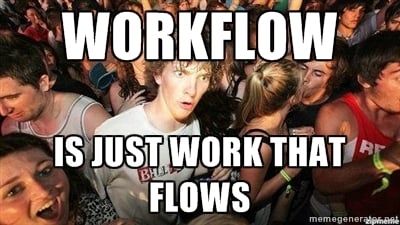 Adam Marquardt
Adam Marquardt
 A Workflow is more than just marketing automation. It’s a series of “if” and “then” descriptions that when set to trigger in a strategic format, will help you save time and convert more contacts into customers.
A Workflow is more than just marketing automation. It’s a series of “if” and “then” descriptions that when set to trigger in a strategic format, will help you save time and convert more contacts into customers.
Think of the marketing automation, or workflow setup like plumbing. You are piping your leads through a series of synchronized marketing events that prepares your target market to be ready for the next stage in the marketing or sales funnel. These events can be triggered based on a contact’s entered information on a form or on an individual’s interests and actions.
Workflows lead the relationship with your contacts and customers with an understanding of what it takes to move to the next level. For each campaign you must know your target's decision process, define your goals, and create a strategy that is aligned to both. These items working together lead your contacts and customers toward your predefined goals and enables your team to further develop the relationship, or to close a sale.
So let’s begin with step 1...
1. Know Your Target
Personalization is key to increasing engagement in your messaging with your audience. HubSpot knows this best, now even utilizing smart content to target messaging to each individual visitor to your website.
And within HubSpot’s set of marketing tools exists the ability to send the right message to the right person at the right time.
Actions should be triggered based on the information you have about your leads. Some ideas of possible ways to target your Workflows include:
-
Leads from a particular geographic location
-
Leads from companies in a particular industry
-
Leads with job titles as upper management vs those in entry level positions
-
Leads who viewed a specific page on your website, such as your pricing or case studies
-
Leads who downloaded a past eBook on XYZ subject matter
-
Leads who abandoned a shopping cart
Did you notice that most of these target factors are in a sense, behavioral based? You should be looking to target messaging based on previous interactions with your website, and/or based on anticipated actions your visitor would take because of granular aspects of who they are, rather than the bigger picture.
2. Define Your Goals
What good is marketing automation if you aren’t sure of the next steps in your marketing funnel that a lead should take to shift them into a sales qualified lead?
Marketing automation needs to build the relationship with your contact. It should develop trust. And it should provide just enough knowledge and assistance in addressing their pain points that they commit to following through on the next conversion point, and hopefully in the end a sale.
Most marketing automation “strategies” we see look like this:
-
Send email
-
Wait 2 days
-
Clicked through to new offer? Yes/No
-
If no, send follow up in 2 days to repeat action
-
If yes, send step 2 email
-
Wait 4 days
-
Repeat steps 3-5
Unfortunately folks, your leads don’t all move this perfectly through the automation process. This is why behavioral based timing and messaging of are so important. If you can talk to your potential customers about what they care about, when they care about it, it doesn't get much better than that.
Where is the relationship building in this type of workflow?
Your leads aren’t sitting there simply waiting for your next email. Interact with them on social media. Be sure that when they search your brand or products or services on Google, your website is optimized and able to be found. And if in between automated emails the lead is returning to your site to look at particular pages of interest, your workflow messaging should adjust to speak to that person’s immediate interests.
It’s about defining the life cycle stages of your prospects. MarketingSherpa found that 61% of B2B marketers send all leads directly to Sales, but only 27% of those leads are actually qualified or ready to talk to Sales.
Keep your follow-up offers aligned with the original conversion point. Identify through analytics and trial and error the point in which an opportunity shift arises to send a conversion offer more focused around your business and how you provide solutions to the potential customer's pain points. For example, you may now be at the point of a webinar, demonstration, or consultation that is more than the strictly educational offers you’ve sent them up to this point. That may be one step away from allowing them to move out of information gathering and into buying mode.
Know where to unenroll your active contact in the marketing automation Workflow and notify your sales team the lead has evolved and may be ready to buy.
Achieving the Final Strategy
By segmenting your leads based on behaviors and granular aspects of who they are, your workflows and targeted messaging becomes more niche, manageable, and relevant. Be sure to continually monitor your social interactions with leads and email open/click rates within your Workflows.
The best and final strategy should always be to build the relationship and trust with your leads, followers, or customers through the variety of marketing channels in your hands. Marketing automation isn’t the end-all-be-all. It’s only a tool to increase the quality of leads that get passed to sales and continually develop those relationships.

